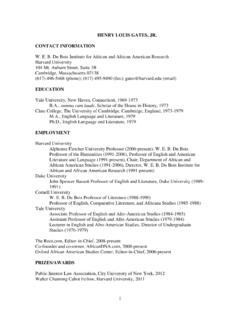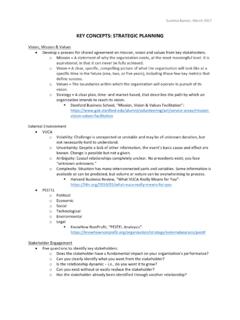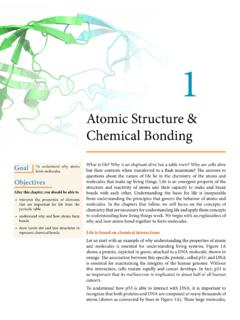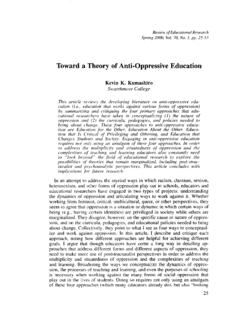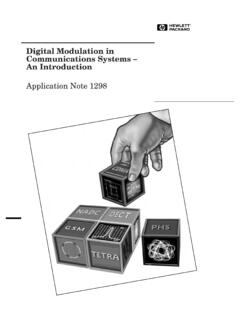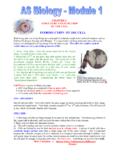Transcription of Proteins & Amino Acids - Harvard University
1 5. Proteins &. Amino Acids Many of the most important macromolecules in living systems are polymers. Goal To understand how common and dissimilar features of These polymers are composed of small building blocks that are linked Amino Acids determine together in long, linear chains. Three of the most important biological the chemical and physical polymers are polysaccharides, polynucleotides, and polypeptides (Figure properties of Proteins . 1). Polysaccharides, such as starch, are composed of sugar subunits whereas polynucleotides, such as DNA and RNA (the subject of Chapter 8), are built Objectives from nucleotides. Here and in the next chapter we focus on polypeptides. After this chapter, you should be able to Polypeptides are chains of subunits called Amino Acids that are joined together by peptide bonds. Short polypeptides are called peptides, and explain why peptide bonds are polar long polypeptides are typically called Proteins .
2 Proteins are composed of and prefer the trans configuration. 20 kinds of Amino Acids , which are at once alike and dissimilar. They share explain how side chains confer distinct common features that allow them to form peptide bonds with each other chemical and physical properties on Amino Acids . while also exhibiting distinctive chemical features. This diversity of Amino Acids and the sheer number of possible combinations in their linear order draw a peptide of a given sequence at a allow for tremendous dissimilarity in the chemical and physical properties specified pH. of Proteins (Figure 2). Furthermore, Proteins do not exist as unstructured chains. Rather, they fold in on themselves to form three-dimensional architectures with unique features. Proteins have diverse functions Owing to their enormous diversity, cells employ Proteins to perform numerous tasks (Figure 3). Some Proteins function as enzymes, which catalyze chemical reactions by reducing G.
3 Nearly all enzymes are Proteins , and as we saw in the previous chapter, cells are able to carry Chapter 5 Proteins & Amino Acids 2. Figure 1 Polymers are Monomer Polymer macromolecules composed of small-molecule monomers linked Carbohydrate OH HO HO. O HO. together in chains HO. O. O O HO. O. HO O OH O OH O. OH HO OH O. HO. Carbohydrates, Proteins , and nucleic Acids OH HO HO. OHO. are examples of biological polymers. Each Sugar Starch class of molecule is made of monomer subunits covalently linked together in S. chains. Protein O. O O O. H H. HO OH N N. N N N. NH2 H H H. O O. Amino acid OH. Protein H2N N H. NH2 O N NH2. N H. N N O N O N. O N. Nucleic acid O N N. P N N N. O N. O. O O O O. O O O. O P O O P O O P O O. OH. O O O. Deoxyucleotide DNA. Figure 2 Proteins exhibit unique (A) (B). structures and chemical properties Surface charge representation of the Proteins actin (A) and HIV protease (B).
4 Even though both Proteins are chains of Amino Acids , they each feature distinct three-dimensional shapes with unique chemical properties, as evidenced by the unique distribution of surface charges on each molecule. Blue represents positive charge, red negative charge, and white actin HIV protease neutral. out controlled chemical reactions because they use enzymes to modulate reaction rates and couple favorable processes with unfavorable ones. In fact, nearly all transformations that occur in the cell are mediated by enzymes, and without them, living systems would carry out virtually no chemistry. Enzymes catalyze a wide variety of reactions and are often categorized according to the chemistry that they perform. Most enzymatic reactions involve either the transfer of electrons (oxidation and reduction reactions), the transfer of functional groups, the cleavage or formation of bonds, the rearrangement of bonds within individual molecules, or the use of ATP to covalently connect molecules.
5 We will have more to say about how enzymes lower G in subsequent chapters. While enzymes come in many shapes and sizes and facilitate a vast number of specific chemical reactions, Proteins as a whole are even more diverse. Not all Proteins are enzymes; some Proteins play structural roles. Hair is made of such Proteins , as are fingernails and the outer layers of the skin. Many familiar materials, such as wool, silk, and leather are also made of protein. These structural Proteins have evolved to withstand particular Chapter 5 Proteins & Amino Acids 3. Structural Proteins These Proteins have evolved to withstand mechanical stress. These include Proteins like keratin that make up your hair and skin, as well as Proteins like actin and tropomyosin that enable muscle contraction. Tubulin Tubulin is a cytoskeletal protein that provides the internal scaffold required for cell division.
6 Enzymatic Proteins These Proteins speed up chemical reactions involved in digestion, blood clotting, replication, transcription, translation, etc. DNA Polymerase DNA polymerase catalyzes the elongation of the growing DNA strand during DNA replication. Regulatory Proteins These Proteins coordinate the events within and between cells. They turn various cellular processes on and off.. Src Kinase Src kinase is a regulatory protein whose misfunction is found in many types of cancer. Carrier Proteins These Proteins help deliver molecules to different parts of cells and organisms. These Proteins are involved in processes such as respiration, metabolism, and nerve stimulation. Hemoglobin Hemoglobin is found in red blood cells, where it carries O2 throughout the body. Figure 3 Proteins have a broad range of structures and functions Example Proteins are displayed using a surface representation.
7 Proteins are colored by polypeptide chain. mechanical stresses and afford protection to the organisms that produce them. On a cellular level, structural Proteins contribute to the physical integrity of the cell and are responsible for much of the organization and compartmentalization found in living systems. For example, cytoskeletal Chapter 5 Proteins & Amino Acids 4. Proteins like actin and tubulin are often used as scaffolds to position and control the movement and localization of other cellular molecules. Thus, even within the seemingly narrow category of structural Proteins , we observe a wide range of structures, functions, and behaviors. Proteins are also used to regulate a multitude of cellular processes. We have already pointed out that life depends on chemical reactions occurring on a rapid timescale; however, it is also necessary for these reactions to be precisely coordinated.
8 Thus, the activities of various enzymes are regulated (turned on and off) by other Proteins that coordinate cellular processes by responding to environmental conditions. In later chapters we will look at how Proteins regulate when and where RNA is produced from DNA, and later we will examine a specific regulatory protein, Abl, whose malfunction results in cancer via deregulation of cell division. Some Proteins act as carriers for other molecules. One example is hemoglobin, which carries oxygen gas to facilitate its transport through the circulatory system. Cholesterol and lipids are also carried throughout the bloodstream by protein carriers. Some Proteins are not as easy to classify. For example, ion channels, which allow ions to pass through cell membranes and are critical to muscle contraction and neurotransmission, can be thought of as enzymes (because they catalyze the transport of ions across lipid bilayers) or as carriers (because they deliver ions from one side of the membrane to the other).
9 A protein's shape determines its function Figure 4 shows the X-ray crystal structure of DNA with a protein bound to it, as we saw in Chapter 1. An X-ray crystal structure describes the near- exact position of each atom in the molecule in three-dimensional space. The technique for obtaining such a structure involves the use of X-rays (a form of electromagnetic radiation) and a crystal of the molecule in question. A. Figure 4 The structure of DNA is predictable, but Proteins fold into a wide range of three-dimensional DNA. structures double helix Shown is an X-ray crystal structure of the p53 protein p53 protein bound to a DNA double helix. DNA adopts a predictable double-helix structure, regardless of its sequence. The structures of Proteins , however, vary widely depending on the specific sequence of Amino Acids of which they are composed. Chapter 5 Proteins & Amino Acids 5. beam of X-rays penetrates through the crystal lattice.
10 Some of the X-rays are diffracted as they encounter the individual atoms that make up the molecules in the crystal lattice. The diffraction creates a characteristic pattern of reflections that is collected on an X-ray film and from which the arrangement of atoms can be reconstructed. This technique is a common method that scientists use to determine the structures of Proteins and other molecules of life, and you will see many representations such as these throughout this book. Figure 4 shows the iconic double-helical structure of DNA. DNA is almost always a double helix regardless of its nucleotide sequence; it essentially always has the same three-dimensional shape. In contrast, the protein in Figure 4 looks quite different from the Proteins in Figures 2 and 3. This is because the three-dimensional structures of Proteins are highly varied. The ability of different Proteins to assume a wide range of distinct three- dimensional conformations is in large part why they are so versatile.
